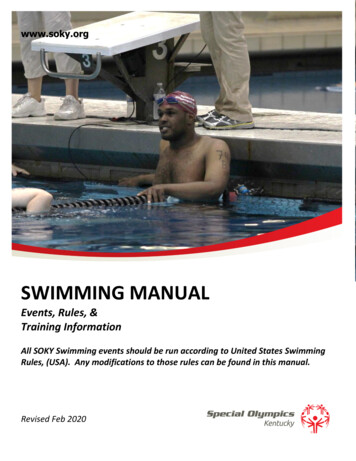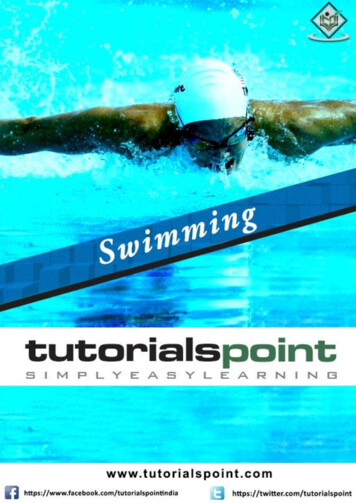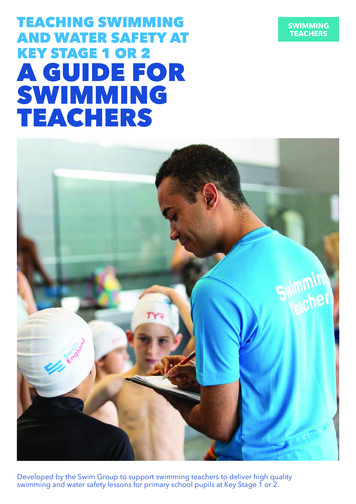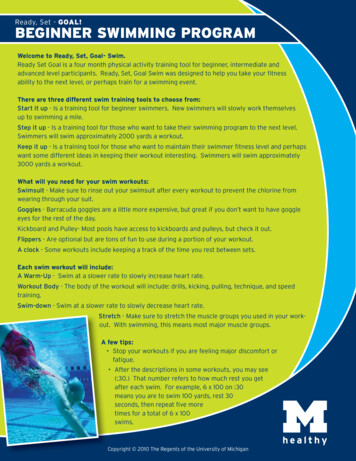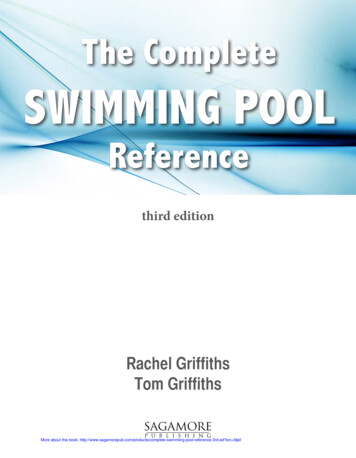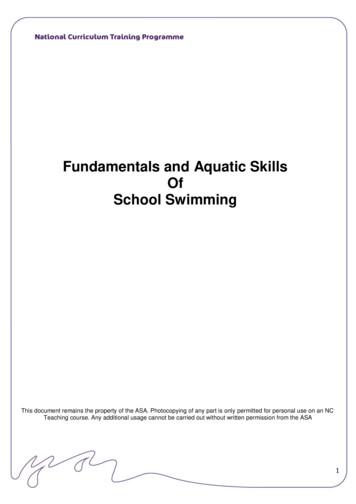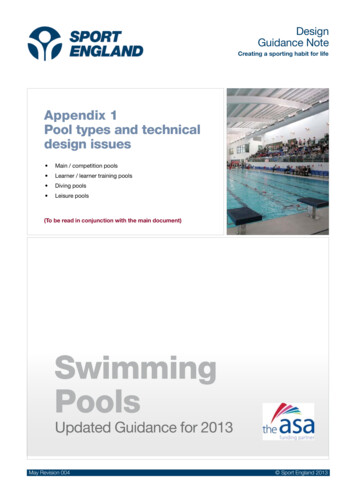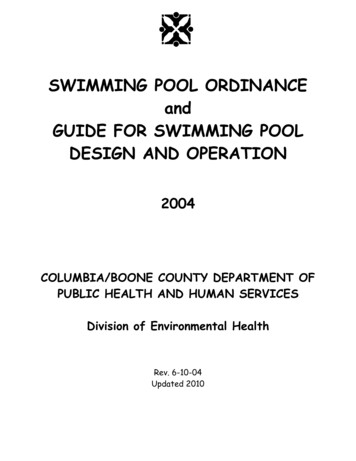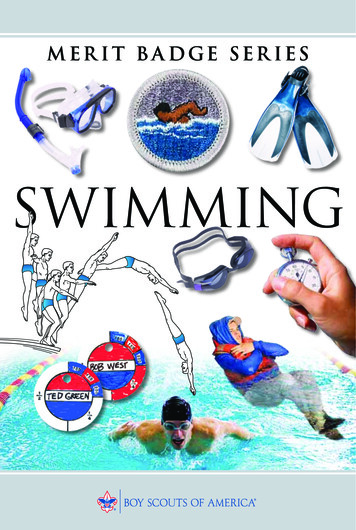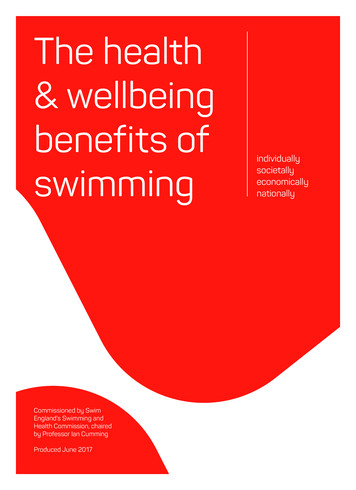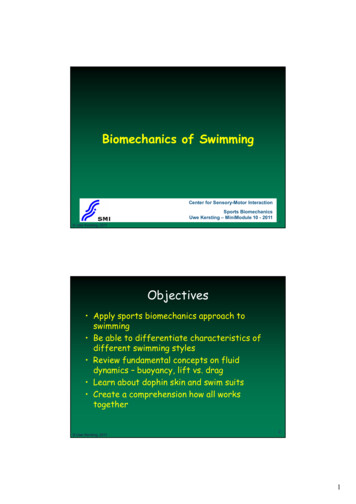
Transcription
Biomechanics of SwimmingCenter for Sensory-Motor InteractionSports BiomechanicsUwe Kersting – MiniModule 10 - 20111 Uwe Kersting, 2011Objectives Apply sports biomechanics approach toswimming Be able to differentiate characteristics ofdifferent swimming styles Review fundamental concepts on fluiddynamics – buoyancy, lift vs. drag Learn about dophin skin and swim suits Create a comprehension how all workstogether Uwe Kersting, 201121
Contents1.Introduction: four main swim styles2.What we can see: characterisation of thefour styles3.Fluidynamics principles- drag- lift- about surfaces and adjacent materials4.Simple calculations5.Finetuning of swim style understanding (?)6.Summary3 Uwe Kersting, 2011Videos4 swimming styles & . Uwe Kersting, 201142
Factorial Model ofSwimming Performance‘partial times meBlock timeReactiontimeFlight timeGlide timeMovementtimeGlidedistanceVert Velat TOVerticalimpulse intakeoffHeightabove waterAverageglide speedHorizspeed atentryHorizontalimpulse intakeoffChanges inhoriz speedin glideHorizontalimpulses inglideMass ofswimmer Uwe Kersting, 2011Starting timestart depends on horizontal and vertical impulsesproduced on the blockspeed in air greater than speed in water: optimise time inthe air.however, too much height in the start producesgreater downward speed which must be stopped inthe water appears to slow the swimmer downgrab vs sprint starts: grab is faster off the blocks, butsprint start greater impulse (what is the objectiveof the start?)maximum impulse in minimum time- beware of “first out of the blocks” syndrome- when to start stroking? When your glide speed drops toyour swimming speedI m*v Uwe Kersting, 20113
Factorial Model ofSwimming, agestroking speedTurningdistanceAverage strokelengthPropulsiveforcesPropulsivelift forcesPropulsiveforces (arms)Propulsivedrag forcesAverage ulltimeRecoverytimeWavedragPropulsiveforces (legs) Uwe Kersting, 2011Stroke lengthPropulsive forces:lift forces – from sculling actionsdrag forces – from pull actionlegs contribute to propulsion in whip and dolphinkicks, but less so in flutter kickResistive forces:form drag – X-C area (viewed from the front)surface drag – typically small, reduced by flutterkick. Also by speed suitswave drag – caused by lifting water above surfacelevel(minimise rolling and vertical motion ofthe body) Uwe Kersting, 20114
Basic propulsion instructions“new water”Hand to move into still water and accelerate it(generate a force against it)hand must move in a 3 dimensional curveif the hand moves in a straight line backwards,it cannot accelerate as much water!“lift”additional force can be gained by pitching thehand so that it acts as a wing (producing liftas well as drag)this is called ‘sculling’ Uwe Kersting, 2011Factorial Model ofSwimming, meAverageturn timeGlidetime inTurntimeNumberof turnsGlidetime outTurntechnique Uwe Kersting, 20115
Turnsturns take between 20 – 35% of race time!Percentage of total race timethe longer the race the more important turnsbecomeObservational research has shown that a ‘piked’turn is faster than a ‘tucked’ turnStrokingTurningStartingDistance (yd) Uwe Kersting, 2011Physics principles needed forswimmingNeed to stay at the surfaceNeed to produce propulsive forcesNeed to minimise resisitive forcesDefinitions and conceptsApplication to swimming Uwe Kersting, 20116
Definition of a “Fluid”A fluid is any substance that tends to flow orcontinuously deform when acted uponGases and liquids – fluids with similarmechanical behavior-- but compressible vs. incompressible Uwe Kersting, 2011Relative VelocityVelocity of a body with respect to thevelocity of something else such as thesurrounding fluidThe velocity of a body relative to a fluidinfluences the magnitude of the forcesexerted by the fluid on the body Uwe Kersting, 20117
Other important FluidPropertiesFluid Density - mass per unit volume(i.e., 1 g/ccm), ρ 1 g/cm3Fluid Viscosity - internal resistance of afluid to flow (oil vs water)In addition:Temperature & atmospheric pressure affectboth above Uwe Kersting, 2011Forces exerted by fluids: Buoyancy in water, the buoyant force equals theweight of the volume of water displaced.the “centre of buoyancy” is at the centreof mass of the volume of water displaced Uwe Kersting, 20118
Will a body float or not?A body will float only if:Wt of body Wt of an equal amount fluidThis can also be stated as:Weight of body 1Weight of an equal amount of fluidtermed: “Specific Gravity of Body” Uwe Kersting, 2011Specific gravity of a bodyEffects of:1. Volume of air inlungs2. Age (very young orvery old)3. Females vs Males4. Body composition Uwe Kersting, 20119
Forces exerted by fluids: Buoyancy weight: magnitude ofbuoyant force ona given body weight of thefluid displaced bythe bodyWeightWeightBuoyantForceBuoyantForceWeight Uwe Kersting, 2011Pressure approachPx ρ * h xPPx Uwe Kersting, 2011h2010
In a wave .A circular shapeis a bad bodysurfer.A wave is . Uwe Kersting, 201121Wave Drag energy loss motion at theinterface of body andfluid causes waves,takes energy and slowsdown theswimmer/boat/etc. But you can use waves!In swimming, the lanemarkers are designedto reduce wave motionbetween lanes Uwe Kersting, 201111
DragDrag resistance force - slowing themotion of a body moving through fluidDrag force:FD 1C2DρAΡv2FD drag force; CD coefficient of drag;ρ fluid density, AP projected area of body orsurface area of body oriented to fluid flow; v relative velocity of body with respect to fluid Uwe Kersting, 2011Examples of Coefficient of Drag Uwe Kersting, 201112
Factors affecting DragFD 1C D ρAΡ v 22CD affected by shape & orientation of bodyto relative to fluid flowρ medium density – e.g., air densitydecreases with altitude 1968 OlympicGames in Mexico City (2250m) – manyworld records set!v greatest effect!!! “Theoretical squarelaw” – if e.g., cyclist at double speed; otherfactors remain unchanged: drag forceopposing increases 4 times!!!! Uwe Kersting, 2011Form Dragform drag depends on the crosssectional area presented to theflow‘streamlining’ is an attempt tominimize form dragsometimes you want to maximize formdrag:oar bladesailing downwind Uwe Kersting, 201113
What is Form Drag?Separation of flow from boundary andsubsequent re-uniting of the divergentpaths causes a “pocket” to be formedbehind moving bodyPocket has “lower pressure” versus “highpressure” resulting from oncoming airflowstriking the front of the bodyWhenever a pressure differential exists, aforce is directed from the region of highpressure to the region of low pressure FORM DRAG ( CD) Uwe Kersting, 2011An example: streamlining(short) Uwe Kersting, 201114
Laminar vs Turbulent flowLaminar – flow in parallellayersTurbulent – flow withviolent intermixing offluidAffected by :1. form of body2. relative velocity3. surface roughnessof body Uwe Kersting, 2011Modifying boundary layer turbulenceyou can reduce drag by reducing turbulencea rough patch on the surface will reduce theseparation angle and thus reduce dragImages of a ball in a wind tunnel. On the right, the ball had sand gluedto the front of it. Notice the separation angle change Uwe Kersting, 201115
Speed suitsmany sports now use suits which incorporate roughpatches designed to reduce the separation angleand decrease the drag Uwe Kersting, 2011What is surface drag?Example: water rushes past an object, layerof water in contact with object is sloweddown due to forces the object’s surfaceexerts on it - that layer of air slows downthe layer of air next to it etc. .Boundary layer: region within which fluidvelocity is diminished due to shearingresistance caused by boundary of movingbodyDepending on velocity & nature of body, theboundary layer becomes unstable &turbulent – i.e., change from laminar toturbulent flow! Uwe Kersting, 201116
Surface Dragsurface dragdepends on thesmoothness of thesurface and thevelocity of flowshaving in swimming –big effect?other examples ofsports to decreasesurface drag .? Uwe Kersting, 2011A note on the technologicaladvancement of the swimsuits Uwe Kersting, 201117
The Perfect MaterialIn the past: Hairless skin better than suitHuman skin: Too porous, turbulence too highShark skin: Scales spaced very closely togetherHydrophobicity, turbulence control – Dragresistance “slice the water.”Fastskin I and II developedby SpeedoCoverage: Eventually fromfeet to handsOxygen bubbles alongstitches Uwe Kersting, 2011The Perfect ShapeFollowing three years of research thatincluded input from NASA, tests onmore than 100 different fabrics andsuit designs, and body scans of morethan 400 elite swimmers, Speedo haslaunched its most hydro-dynamicallyadvanced - and fastest - swimsuit todate.- February 14th, 2008Extreme tight fit: Streamlinebody shape – reduce (bad)vibrations. Uwe Kersting, 201118
FINA hits the brakes – but too lateIntention: Ban all hi-tech suits before WC 2009Failed to address 136enquiries- all suits were allowedSuper materials: 100%Polyurethane, Hydrofoil Uwe Kersting, 2011 A male suit, mind youRestrictions by FINA – 1st Jan 2010Surface covered: Men swimsuit shall not extend above thenavel nor below the knee and for women shall not cover theneck or extend past the shoulders nor shall extend belowthe knee.Type of material: The material used for swimsuits can be only"Textile Fabric(s)" defined for the purpose of these rulesas material consisting of, natural and/or synthetic,individual and non consolidated yarns used to constitute afabric by weaving, knitting, and/or braiding.Additional rules for: surface treatment, flexibility, varietyof materials, thickness, buoyancy, permeability,construction etc Uwe Kersting, 201119
World Records NeverTo Be Broken?FINA: Records set at WC 2009 willstand.” Though the changes won't go into effect at the worldchampionships that begin Sunday in Rome, they will hangover the competition, seemingly wagging a finger at everyworld-record setter wearing a suit that will never beallowed again in a major swimming championship.”- The Washington Post, July 2009 130 WR’s broken since launch of high-tech suits Uwe Kersting, 2011Magnus Effectif a ball spins in flight, it will drag some of theair close to the surface with it. This createsan area of high pressure and an area of lowpressure on opposite sides of the ballthis pressure imbalance will make the ball curvein flight Uwe Kersting, 201120
An example: streamlining Uwe Kersting, 2011Bernoulli’s principleConsider a “foil” shape – fluid flows over thecurved side & is accelerated while on the flatside it remains virtually unchangedThis difference in velocity of flow creates lowpressure on curved side & high pressure on flatsideRemember that force is directed to foil fromarea of high pressure to area of low pressure .causing “lift” more effective!!!Now! Do the stroke! Uwe Kersting, 201121
freestyle stroke (butterfly is verysimilar) Uwe Kersting, 2011a)b)breaststroke pattern – relative to the a) swimmer and b) pool Uwe Kersting, 201122
LIFT forcedirection of movementDRAG forceDRAG forceLIFT forceDRAG forcedirection of movementdirection of movementvirtually no ‘pull’ in breaststrokescull out, then scull inLIFT forces from L & R limbs add to propulsion insculling motionDRAG forces cancel in sculling motion Uwe Kersting, 2011Lift and Drag Forces on a Discus(Wind v 25 m/s)Angle ofAttack(Degrees)Lift (N)Drag 00.0790.0000.5250.5510.1510.000Angle of attack – angle btwlongitudinal axis of a body &direction of fluid flowNeed to take some drag intoaccount to enable “lift”! Uwe Kersting, 201123
Back to swimming reality: Relationshipsbetween stroke length and frequencySF for freestyle, butterfly and breaststroke aresimilar and greater than for backstrokeas race distance increases, SL increases, SFdecreases and speed decreasesdifferences in ability are due primarily to strokelength, with better swimmers having greater SLsto increase speed in the short term (i.e., on the day)increase stroke frequencyto increase speed in the long term (i.e., over theseason) train to increase stroke length video Uwe Kersting, 2011SummaryFactor (subjective) model – be aware of thecomplexity of mechanical factors in swimmingresistive and propulsive forces – what are they, andhow can you maximise propulsive and minimiseresistive forcesstarts – a case of optimising distance in the air plusdistance in the glidestrokes – how do the principles of ‘new water’ and‘lift’ influence stroke shape?understand the relationships between SL and SFturns – play a much more important part in racesover 100m that most swimmers realise. Turnpractice is essential! Uwe Kersting, 201124
Points to rememberForces exerted by fluidsbuoyancy – magnitude and location ( effect on floating position)Bernoulli’s Principle – increased velocity of flow results indecreased pressurelift & drag forcesresult from objects being in a fluid flow.The drag force is aligned with the flow and the liftforce is perpendicular to it.Maximum lift at 45 , zero lift at 0 and 90 .Form drag depends on the X-C area presented to the flow andgeometryimportant in streamlining and minimizing frontalareaSurface drag is comparably small but may be decisive Uwe Kersting, 2011Acapulco .or what I left out.1 Uwe Kersting, 201125025
Swimming Performance ‘partial times model’ TIME total Starting time Stroking Turning time Block time Flight time Glide time Glide distance Average glide speed Horiz speed at entry Changes in horiz speed in glide Horizontal impulses in glide Mass of swimmer Horizontal impulse in takeoff Mo
